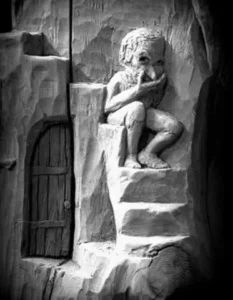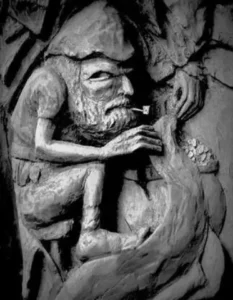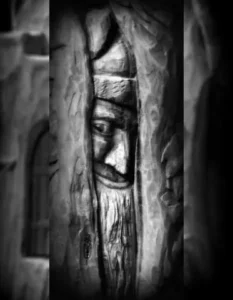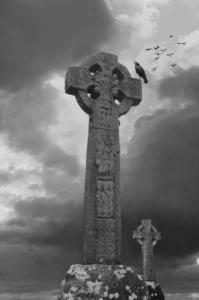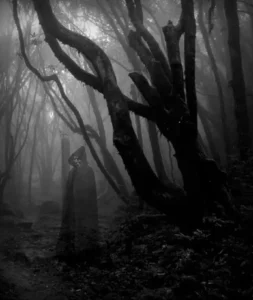

paulnixonart.com
336 707 5502
Welcome to the magical world of Paul C Nixon.
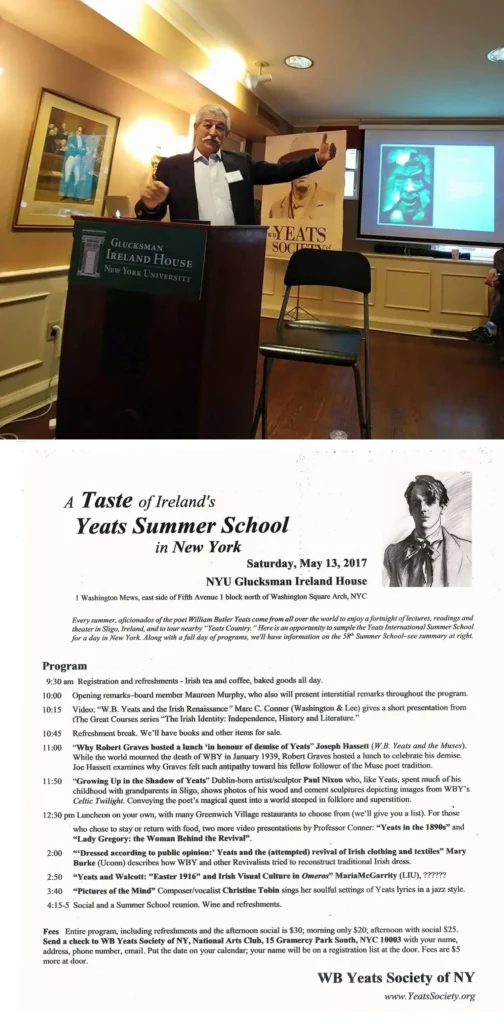
The Irish storytelling tradition is especially rooted in the fairy belief, and the variety of fairys present attest to this. In Irish folklore, the Tuatha de Danann were one of the original inhabitants of Ireland –until a warrior tribe, the Milesians (or Celts) arrived. The Milesians attacked and won a war against the Tuatha de Danann, eventually driving them underground. The Tuatha de Danann used their innate magic to become the Sidhe (pronounced Shee) – today known as the “fairies”, “little people” or the “wee folk”.
A view of the supernatural was fundamental in Irish folklore, and the fairies that populated these stories were at the heart of that believer. Entrances to the Otherworld of the fairies are everywhere – caves, tombs, wells, forts, even tree hollows and roots. Bad luck and illness when offending the fairies often caused people to disappear having been kidnapped by the little people. There are three major fairy types in the Irish fairies that was accepted as truth.—the Sidhe (“Shee”), the Banshee, and the Merrow. Each has their own characteristics that make it unique to Irish folklore. The Sidhe were considered a “distinct race, quite separate from human beings, and belief in this race of beings that had powers beyond those of men to move quickly through the air and change their shape at will. They once played a huge part in the lives of people living in rural Ireland” The Banshee was a variation of the Sidhe, meaning “faerie woman” or “woman of the Faerie mound,” an elfin creature whose mourning call signaled death approaching. The Merrow comes from the Irish word muir meaning sea and oigh meaning maid, an Irish variation of the popular mermaid archetype.
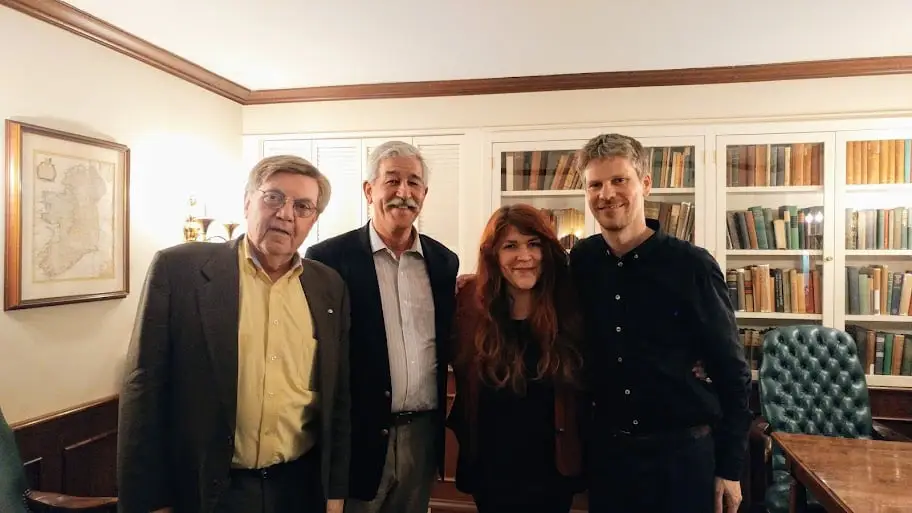
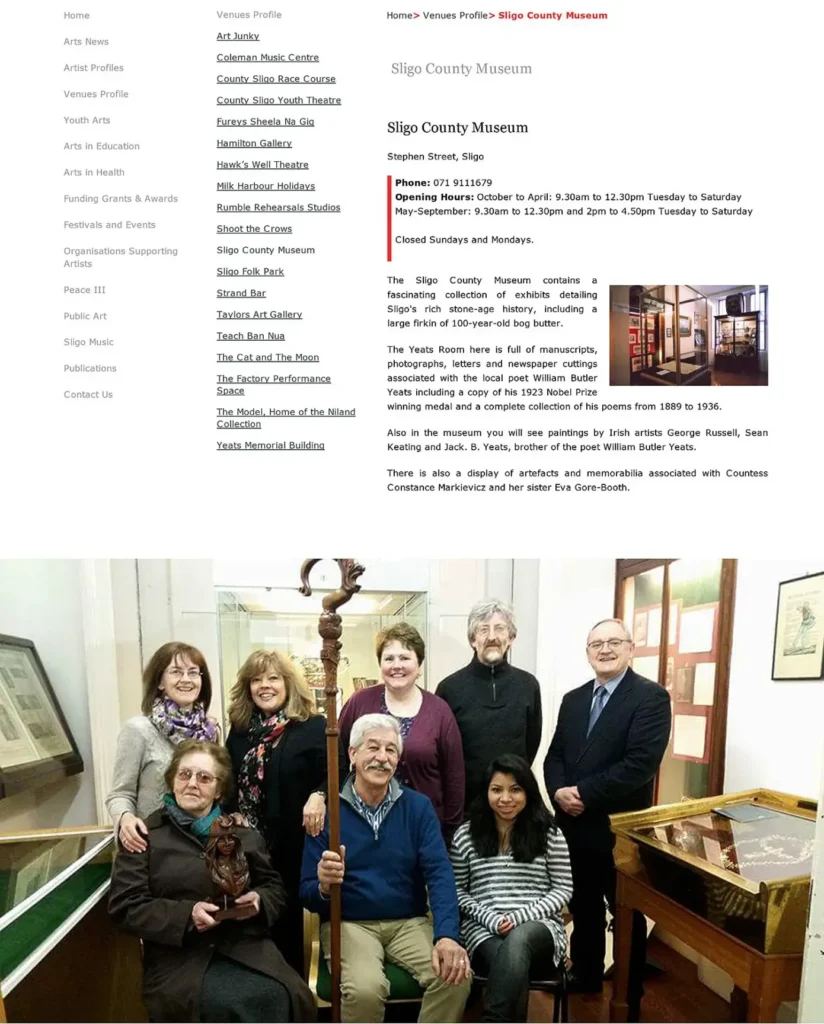
Joined by my mother and family members at the presentation of two of my sculptures at the Sligo county museum, they are displayed alongside the works of William Butler Yeats.
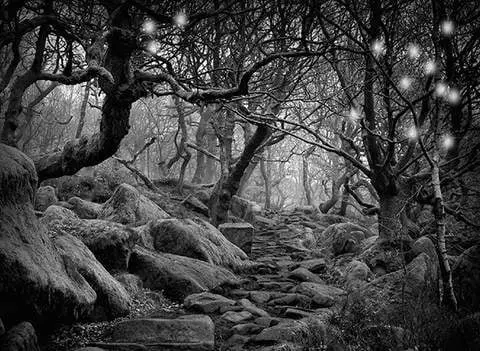
Come, faeries, take me out of this dull house! Let me have all the freedom I have lost; Work when I will and idle when I will! Faeries, come take me out of this dull world, For I would ride with you upon the wind. Run on the top of the dishevelled tide, And dance upon the mountains like a flame.
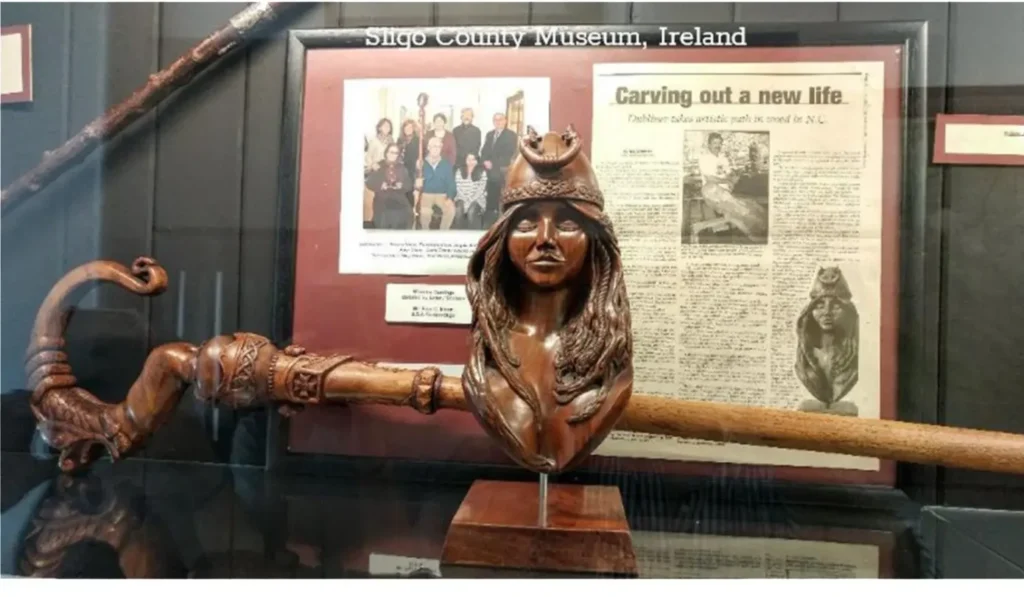
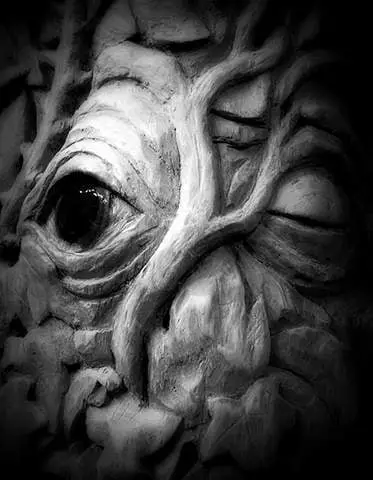
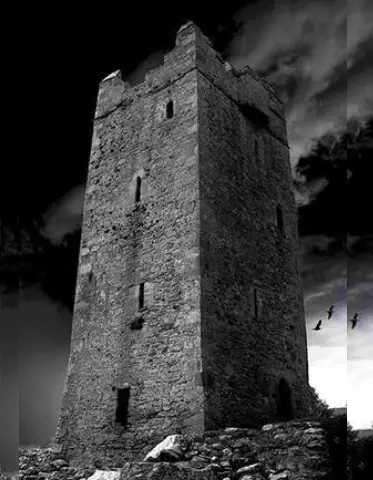
But lived as ’twere a king That packed his marriage day With banneret and pennon, Trumpet and kettledrum, And the outrageous cannon, To bundle time away That the night come. WB Yeats.
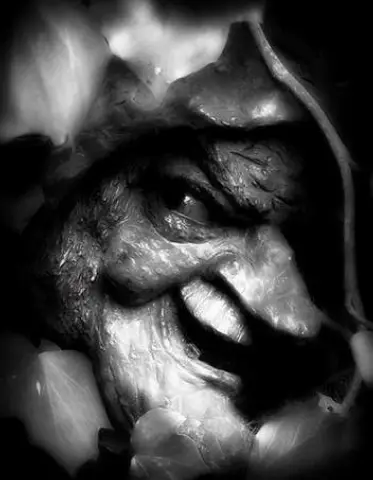
Wicked Witch. Sculpted Cement.
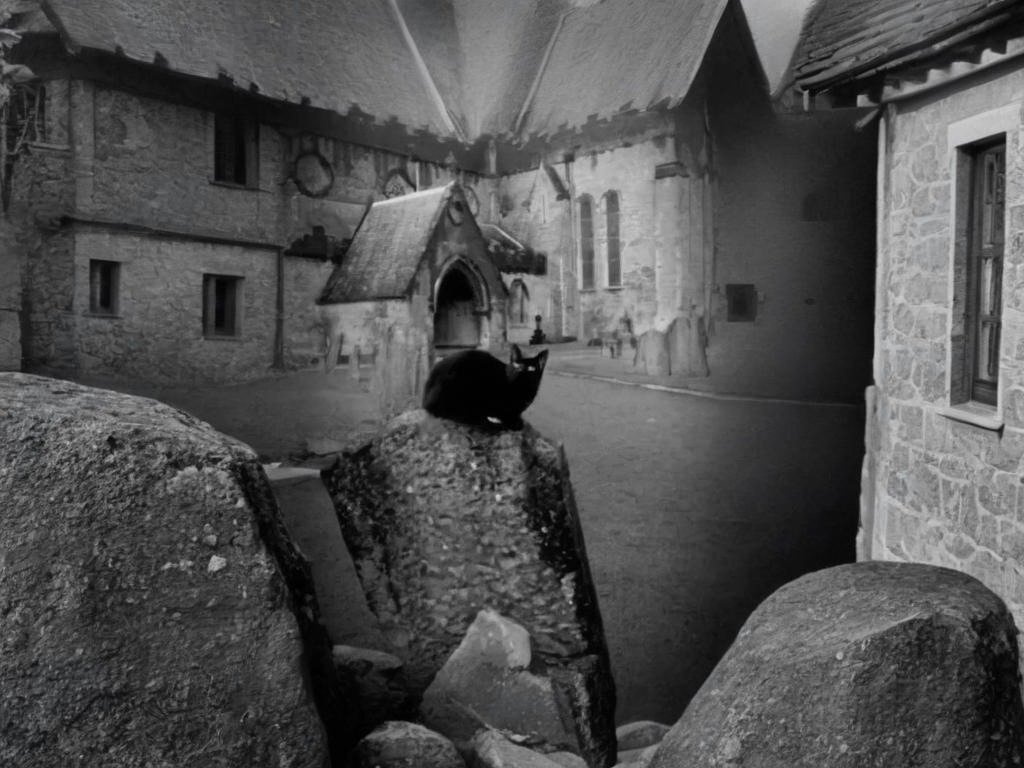
The Witches Familiar, St Canice’s Cathedral. Kilkenny. Ireland.
I encountered this black cat inside the beautiful 13th Century Cathedral in 2016. As I walked down the center aisle It suddenly ran across my path, disappearing beneath the pews on the opposite side. On leaving, the cat followed me outside only to pose in such a way on this headstone.
A brief drive over a picturesque road from where we lived is this wonderful natural mountain formation known as Eagle Rock or The Hags Leap. My grandparents and relatives would tell stories of a supreme deity. She was the ancient crone of divine wisdom who entered the early days of human settlement on this island.
As a young child living with my grandparents, I was immersed in these beliefs. Laying beneath warming layers in the stillness of a frosty moonlit night as my breath rose like an apparition up into the frigid darkness. I could naturally imagine the hag’s formidable form ravaging all of nature’s splendor and reshaping the landscape. This prominent place still echoes her memory. She was proclaimed to despise the summer months. The Cailleach is a crone goddess, traditionally depicted dressed completely in gray with a dun-colored plaid wrapped around her shoulders.

Her intent face is sickly and pale blue like that of a corpse, and her abundant hair is long, white, and matted. She possesses a solitary eye in the center of her forehead, a trait characteristic of deities who can see beyond this world and into the next. One of her key attributes is a mighty hammer which she used to make and break mountains and cause thunderstorms. Wielding a magical white rod made from either Birch or Bramble and is sometimes perceived as blasting vegetation with frost. Her Druidic rod grants her power over the weather and the elements. Every summer An Cailleach gives way to her then turns to stone only to be reborn again on October 31st. She is otherwise recognized as An Cailleach Beara, representing an ancient wife, but also having the ability to shapeshift into a lovely maiden. Ancient tales tell she appears to be a heroic figure appealing for help. When the hero is capable of seeing beyond the ugliness of her form, agrees and fulfills her wish. She would then transform herself into an attractive woman and offer herself as a possible reward. Cailleach is the Neolithic mother of winter and one of the ancient goddesses known to Ireland. She has long survived the passages of time and is genuinely believed to have traveled across Europe to these shores with the receding ice age. November 1 St, a festival understood as the reign of ancient women is celebrated each year and is known as the Day of the Banshee. On the eve of Imbolc (Jan 31st- Feb 1st) also celebrated is the feast called, End of Cailleach, the death of winter and the coming of spring.
Paul Nixon.
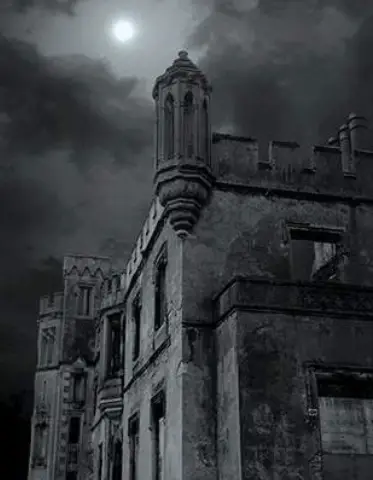
Blood and Moon
“Like everything that has a stain of blood, A property of the living; but no stain Can come upon the visage of the moon When it has looked in glory from a cloud.”
WB Yeats.
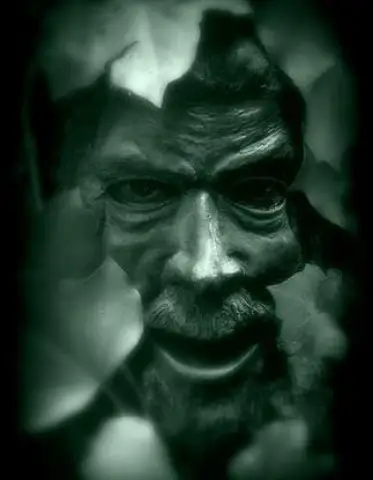
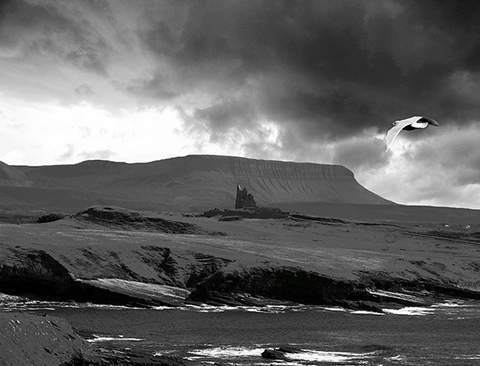
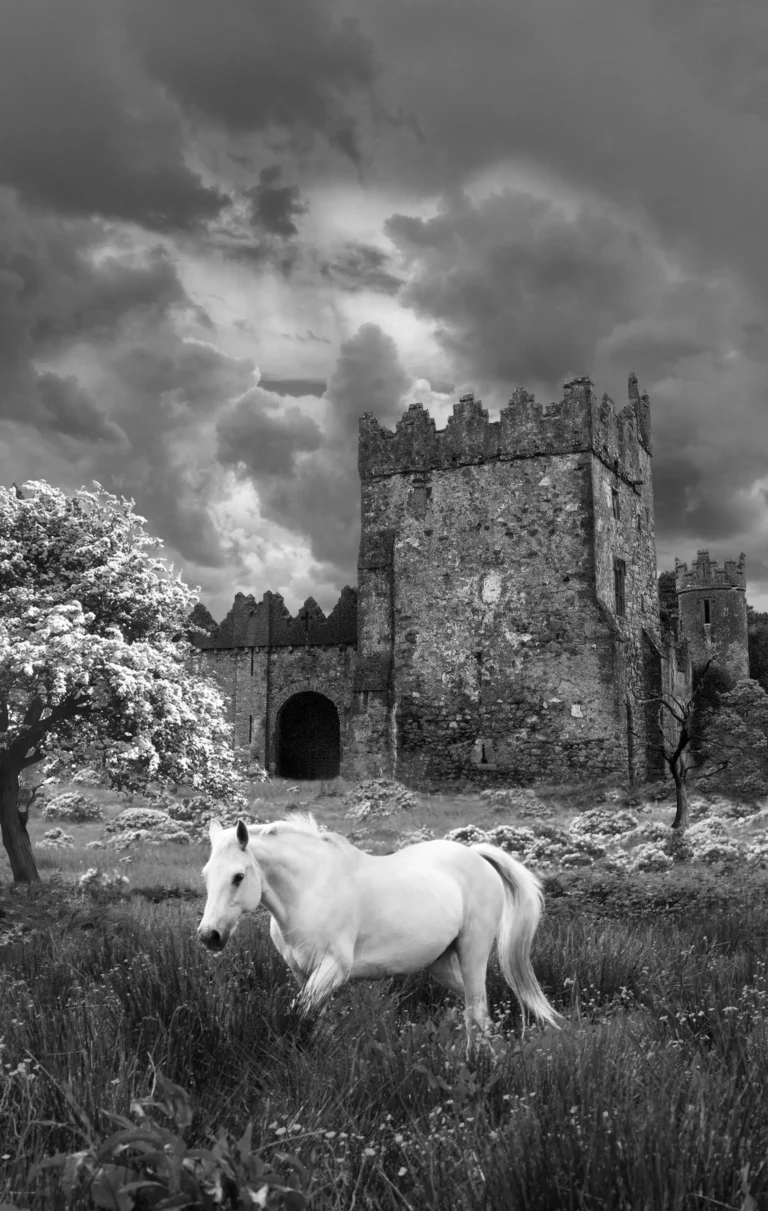
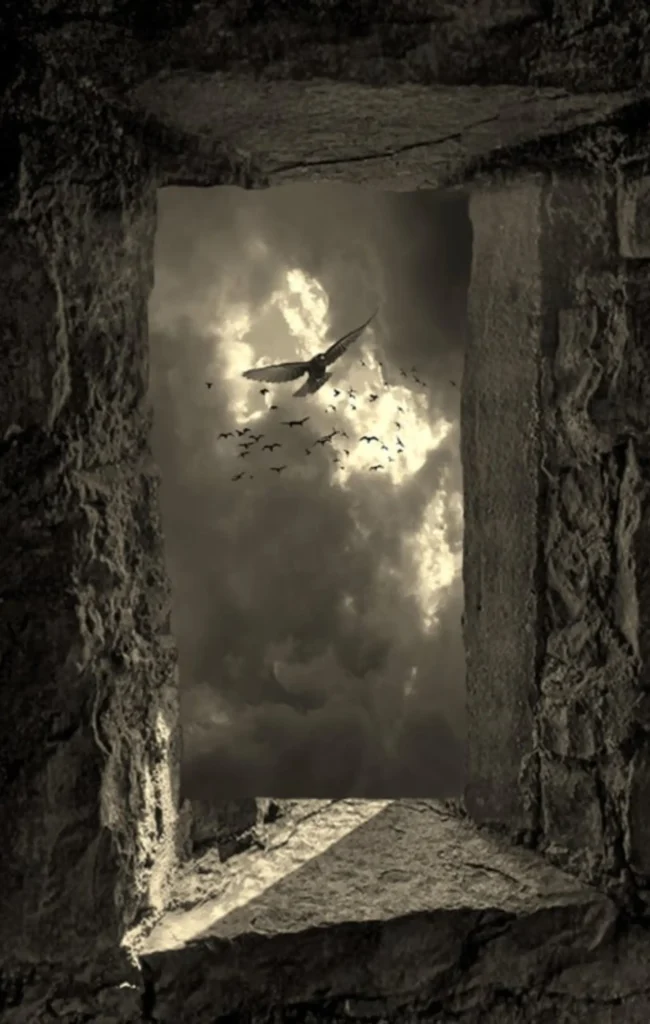
Through The Castle Window. Blarney Castle, County Cork. Ireland.
Through the castle window.
In Celtic mythology, the Morrigan was associated with war, battlefields, death, and sovereignty; she could shape-shift into a crow or raven. Dating back to the Copper Age, she was the dominant Dark Death Goddess of Ireland, Wales and Britain. She is one of the original members of the Tuatha De Danaan (People of the Goddess Danu), an intimidating and fierce Goddess of sovereignty. The Morrigan exists between the worlds of life and death and the Celts believed she could revive their dead soldiers to fight once more. The severed heads on the battlefield were called the “Mast of Macha” (harvest of Macha). The ground was considered sacred after the battle, as the soldiers would leave until the next day so Morrigan could gather the souls undisturbed.
Paul Nixon, Irish folklore.
The Ice Queen. A sculpted cement figure set into altered photography
The Ice Queen. How wide your gathering arms embrace to catch an orbit in flight. Spiteful winds that pierce your space from cold unblinking eyes.
Its stirring in this hush of nature brings a wild pleasure, surrounded by a single motion linking cloud and stone together. I sample its swelling, taste in a cold soundless murmur, fading familiar scenes where wild creatures slumber. Perhaps the Ice Queen has taken her throne within the grandeur of these airy towers, the calm rustle of her lofty gown while her delicate tears devour. I pause awhile in muffled tone an intruder within this expanse. My lagged patterns yield their form, as flakes gather and dance. Hear now your breath on tender lips, cold bodiless and bright, licks as moist droplets slip, to blend me from sight. As ivory wisps descend to the ground to hide the hopes of spring, are a whitewash of marvelous designs. as though fashioned from a dream. I make my way through a path of tales leave behind this enchantment at hand. Before I am lulled by her delicate sway, as her alluring insistence demands.
Paul Nixon

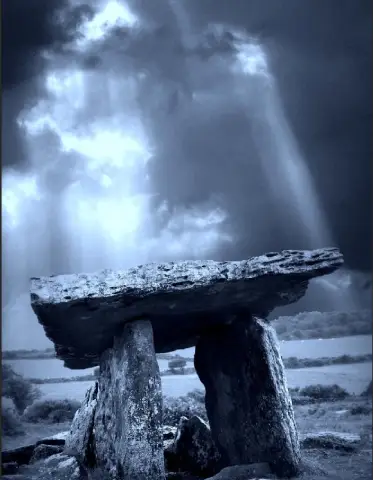
Poulnabrone Dolmen. The Hole of Sorrows. Tomb 4200 BC. County Clare, Ireland.
The Everlasting Voices O sweet everlasting Voices, be still; Go to the guards of the heavenly fold And bid them wander obeying your will, Flame under flame, till Time is no more; Have you not heard that our hearts are old, That you call in birds, in wind on the hill, In shaken boughs, in tide on the shore? O sweet everlasting Voices, be still.
Dark Woman of the Forest. Leanhaun Shee.
“I was dancing with an immortal august woman, who had black lilies in her hair, and her dreamy gesture seemed laden with wisdom more profound than the darkness that is between star and star, and with a love like the love that breathed upon the waters; and as we danced on and on, the incense drifted over us and round us, covering us away as in the heart of the world, and ages seemed to pass, and tempests to awake and perish in the folds of our robes and in her heavy hair.
Suddenly I remembered that her eyelids had never quivered and that her lilies had not dropped a black petal, or shaken from their places, and understood with a great horror that I danced with one who was more or less than human, and who was drinking up my soul as an ox drinks up a wayside pool, and I fell, and darkness passed over me.”
WB Yeats
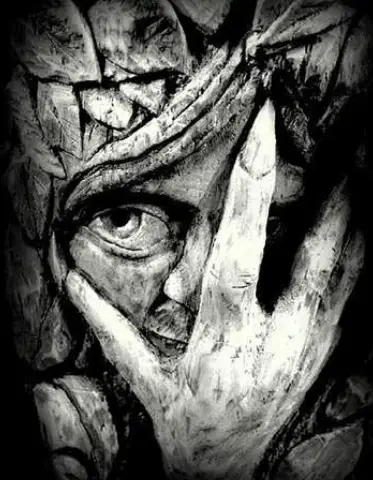
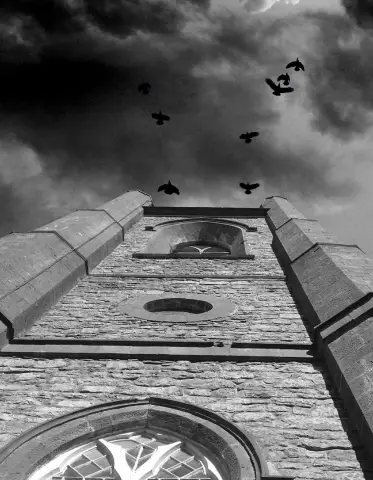
The Cold Heaven
Suddenly I saw the cold and rook-delighting heaven That seemed as though ice burned and was but the more ice, And there upon imagination and heart were driven
So wild that every casual thought of that and this Vanished, and left but memories, that should be out of season With the hot blood of youth, of love crossed long ago;
And I took all the blame out of all sense and reason, Until I cried and trembled and rocked to and fro, Riddled with light. Ah! when the ghost begins to quicken,
Confusion of the death-bed over, is it sent Out naked on the roads, as the books say, and stricken By the injustice of the skies for punishment?
WB Yeats.
SLEEP, my child! for the rustling trees, Stirr’d by the breath of summer breeze, And fairy songs of sweetest note, Around us gently float. Sleep! for the weeping flowers have shed Their fragrant tears upon thy head, The voice of love hath sooth’d thy rest, And thy pillow is a mother’s breast. Sleep, my child! Weary hath pass’d the time forlorn, Since to your mansion I was borne, Tho’ bright the feast of its airy halls, And the voice of mirth resounds from its walls. Sleep, my child! Full many a maid and blooming bride Within that splendid dome abide, And many a hoar and shrivell’d sage, And many a matron bow’d with age. Sleep, my child! Oh! thou who hearest this song of fear, To the mourner’s home these tidings bear. Bid him bring the knife of the magic blade, At whose lightning-flash the charm will fade. Sleep, my child! Haste! for tomorrow’s sun will see The hateful spell renewed for me; Nor can I from that home depart, Till life shall leave my withering heart. Sleep, my child! Sleep, my child! for the rustling trees, Stirr’d by the breath of summer breeze. And fairy songs of sweetest note, Around us gently float. WB Yeats/
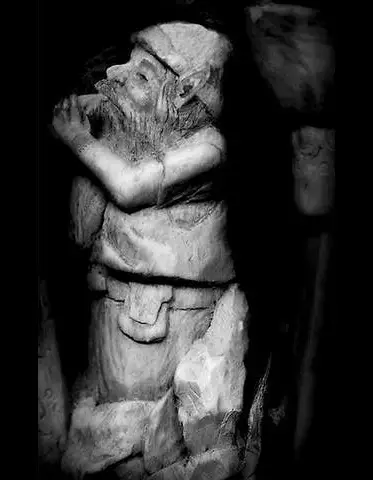
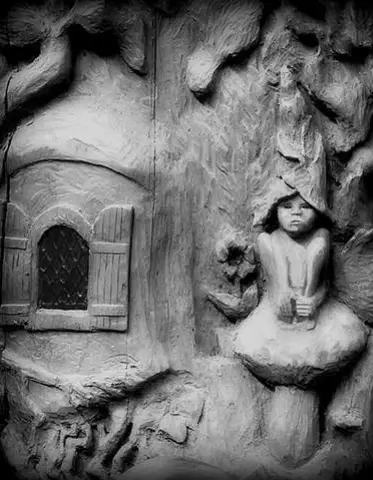
Pixi on Duty. Hand Carved Cedar Wood.
This portion of the song is supposed to have been sung by a young bride who was forcibly detained in one of those forts so common in Ireland and to which the good people are very fond of resorting. Under the pretense of hushing her child to rest, she retired to the outside margin of the fort. She addressed the burden of her song to a young woman whom she saw at a short distance and requested to inform her husband of her condition and to desire him to bring the steel knife to dissolve the enchantment.
THE HARP OF AENGUS
Edain came out of Midhir’s hill, and lay Beside young Aengus in his tower of glass, Where time is drowned in odour-laden winds And Druid moons, and murmuring of boughs, And sleepy boughs, and boughs where apples made Of opal and ruby and pale chrysolite Awake unsleeping fires; and wove seven strings, Sweet with all music, out of his long hair, Because her hands had been made wild by love. When Midhir’s wife had changed her to a fly, He made a harp with Druid apple-wood That she among her winds might know he wept; And from that hour he has watched over none But faithful lovers. WB Yeats.

Pooka“On November Eve they are at their gloomiest, for according to the old Gaelic reckoning, this is the first night of winter. This night they dance with the ghosts, and the pooka is abroad, and witches make their spells, and girls set a table with food in the name of the devil, that the fetch of their future lover may come through the window and eat of the food. After November Eve the blackberries are no longer wholesome, for the pooka has spoiled them.”
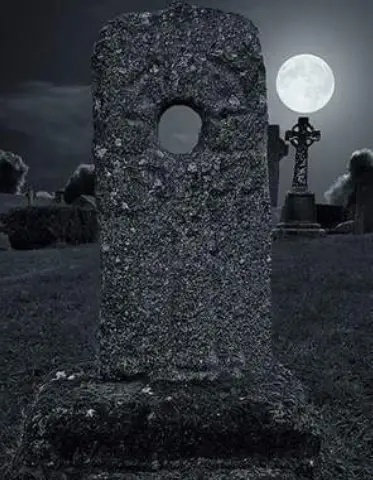
Full Moon on Sacred Ground. St James Graveyard, Castledermot, County Kildare, Ireland.
“Speak, speak, for underneath the cover there. The sand is running from the upper glass, And when the last grain’s through, I shall be lost.”
William Butler Yeats
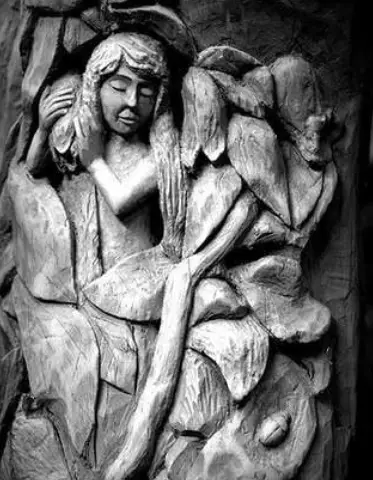
Flower Fairy Hand Carved Cedar Wood.
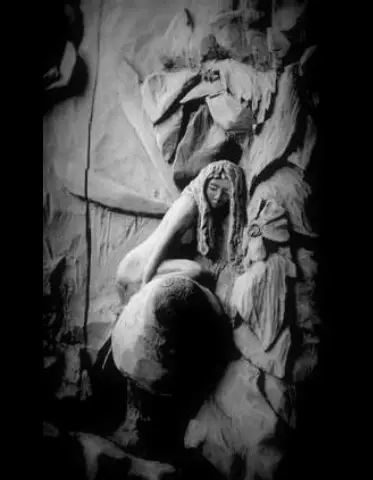
Hand Carved Cedar Wood.
Full Moon on Sacred Ground. St James Graveyard, Castledermot, County Kildare, Ireland.
The Fairy Pedant. Scene: A circle of Druidic stones First Fairy: Afar from our lawn and our levee, O sister of sorrowful gaze! Where the roses in scarlet are heavy And dream of the end of their days, You move in another dominion And hang o’er the historied stone: Unpruned in your beautiful pinion Who wander and whisper alone.
All: Come away while the moon’s in the woodland, We’ll dance and then feast in a dairy. Though youngest of all in our good band, You are wasting away, little fairy.
Second Fairy: Ah! cruel ones, leave me alone now While I murmur a little and ponder The history here in the stone now; Then away and away I will wander, And measure the minds of the flowers, And gaze on the meadow-mice wary, And number their days and their hours– All: You’re wasting away, little fairy.
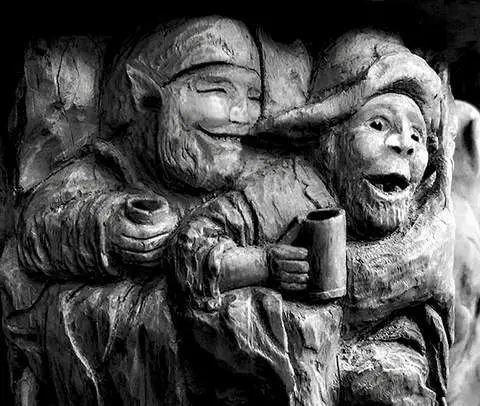
Second Fairy: O shining ones, lightly with song pass, Ah! leave me, I pray you and beg. My mother drew forth from the long grass A piece of a nightingle’s egg, And cradled me here where are sung, Of birds even, longings for aery Wild wisdoms of spirit and tongue. All: You’re wasting away, little fairy. First Fairy [turning away]: Though the tenderest roses were round you, The soul of this pitiless place With pitiless magic has bound you– Ah! woe for the loss of your face, And the loss of your laugh with its lightness– Ah! woe for your wings and your head– Ah! woe for your eyes and their brightness– Ah! woe for your slippers of red. All: Come away while the moon’s in the woodland,
We’ll dance and then feast in a dairy. Though youngest of all in our good band, You are wasting away, little fairy. She’s wasting away, little fairy. All: Come away while the moon’s in the woodland, We’ll dance and then feast in a dairy. Though youngest of all in our good band, You are wasting away, little fairy. She’s wasting away, little fairy. WB Yeats.
A Fairy Song
The wind blows out of the gates of the day, The wind blows over the lonely of heart And the lonely heart is withered away, While the fairies dance in a place apart, Shaking their milk white feet in a ring. Tossing their milk white arms in the air; For they hear the wind laugh, and murmur and sing Of a land where even the old are fair, And even the wise are merry of tongue; But I heard a reed of Coolany say, When the wind has laughed and murmured and sung, The lonely of heart is withered away!”
WB Yeats.
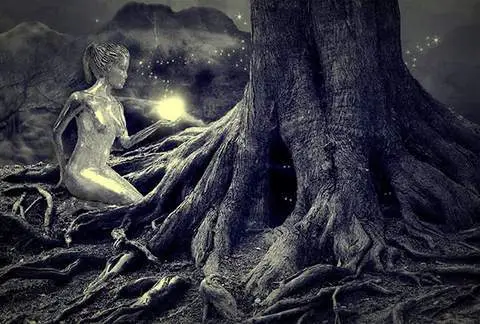
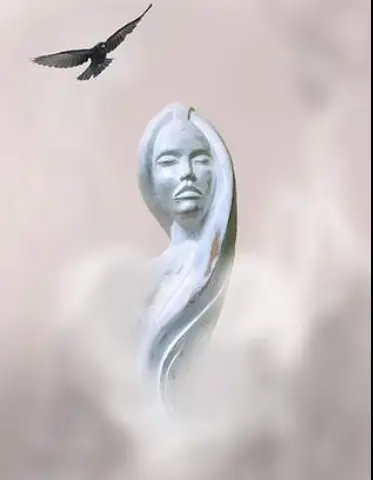
The Rise of the Morrigan.
Hand-carved poplar wood with gesso application set into my altered photographic image.
A sculpted wooden figure is set in my created image. Dating over 5000 years, the Great Goddess Morrigan was the dominant deity throughout Europe. She is the transporter of souls between life and death. She is found where armies gather, where wars rage, and where wisdom and warnings are needed. Only by appealing to her can a warrior become king or an army succeed. On the battlefield, she appears as a crow who can influence the battle’s outcome. The Celts believed as they engaged in the battle, the Morrigan flew shrieking in crow form, summoning a host of slain warriors to a macabre spectral bane. When the battle had ended, the warriors would leave the field until dawn the following day—allowing Morrigan to claim her trophies. Paul Nixon, Irish folklore.
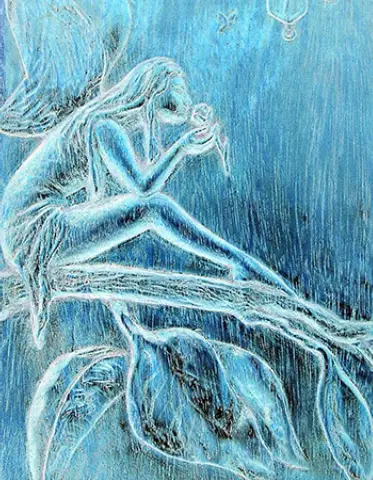
Fairies Delight. Hand carved wood panel.

The Olde Forge. Wicklow, Ireland.
When one looks into the darkness, There is always something there. The hour of thy great wind of love and hate. When shall the stars be blown about the sky, Like the sparks blown out of a smithy, and die? Surely thine hour has come, thy great wind blows, Far-off, most secret, and inviolate Rose? WB Yeats.
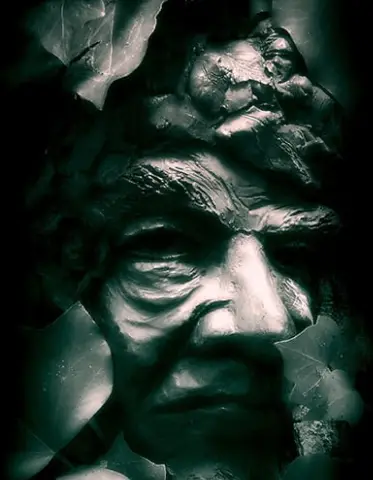
The Green Man. Celtic god of nature. Sculpted cement.
The Green Man for thousands of years has been a mysterious source of origin and history. Associated with the Celts, he is intended as a symbol of growth and rebirth, a forest god, and an emblem of the birth, death, and rebirth cycle of the natural year.
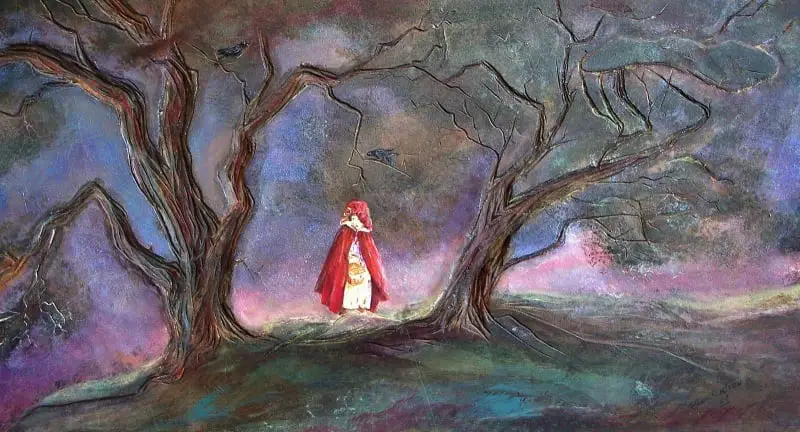
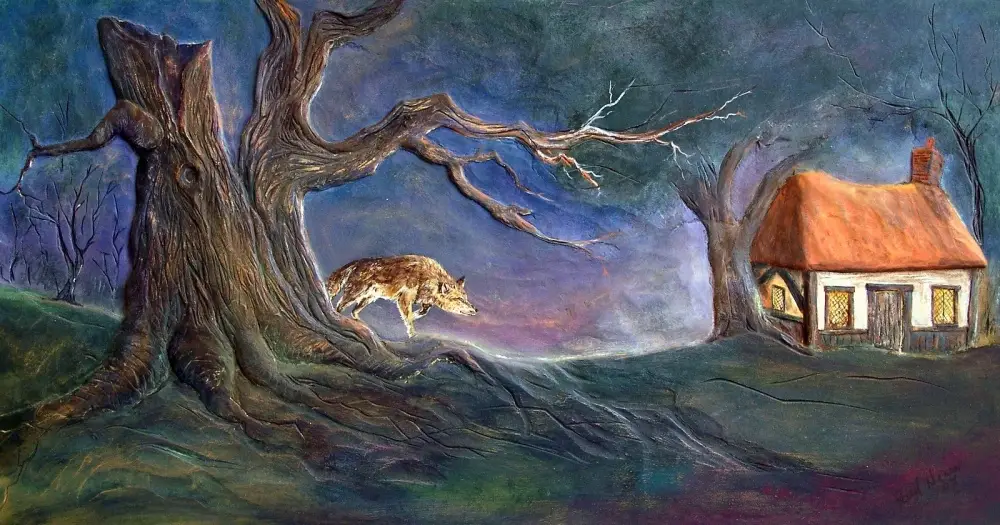
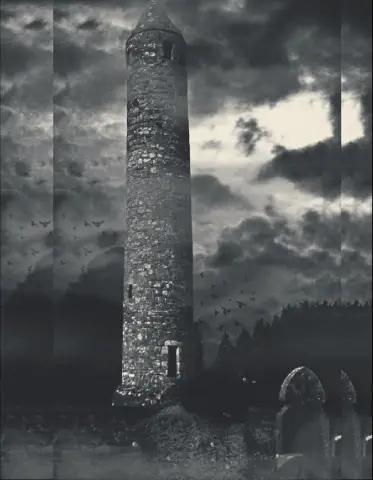
Halloween rendition of Clondalkin Round Tower, County Dublin, Ireland.
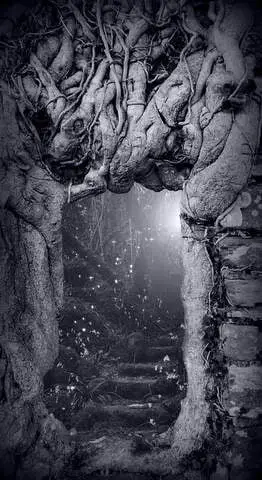
Mist-clad in the light of the moon Starspun seekers – I search for thee! Faery light – I ask thy boon Of branch and thorn and Elder tree! Wood woven creatures, shadow weavers River keepers – come to me! Just beyond reaching Never in keeping Spirits of Faery – I call unto thee! Wind-hewn wildness Dark and brightness Spiral enchantments – born of the sky! Cradle me with elven hands, Abide with me, thy human child! W.B Yeats
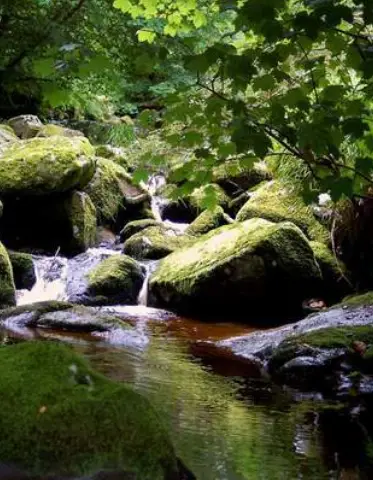
Playground of my youth. A mountain stream that flowed next to my grandparents house. Back in the day this stream was used to keep milk and butter cool. For the hardy in our family it was also used to bathe in. Art. Upon the stream that whirls along To hold the wonderous hue alone Or that delightful undertone Detached from every other song. WB Yeats.

Enchanted Walk
Aedh Wishes for the Cloths of Heaven. Had I the heavens’ embroidered cloths, Enwrought with golden and silver light, The blue and the dim and the dark cloths Of night and light and the half-light, I would spread the cloths under your feet: “But I, being poor, Have only my dreams; I have spread my dreams under your feet; Tread softly because you tread on my dreams. WB Yeats.
Aedh being the speaker of the poem – a pale, sensitive, Keatsian, Romantic figure of a poet. Aedh, was considered the god of death in Irish mythology, was one of four characters who appear in Yeats’s poetry in the middle of his writing career.
Enchanted Walk
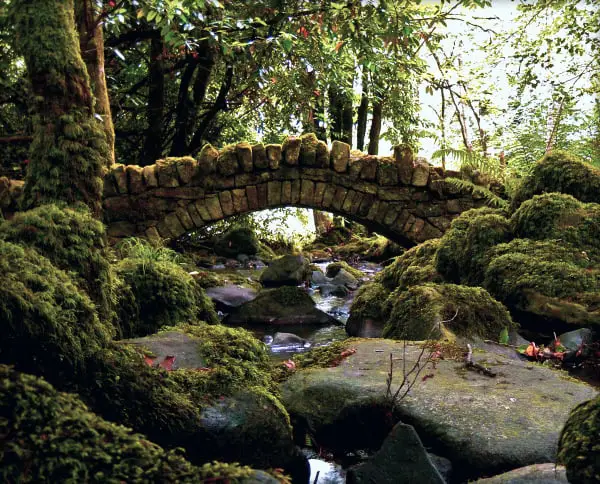
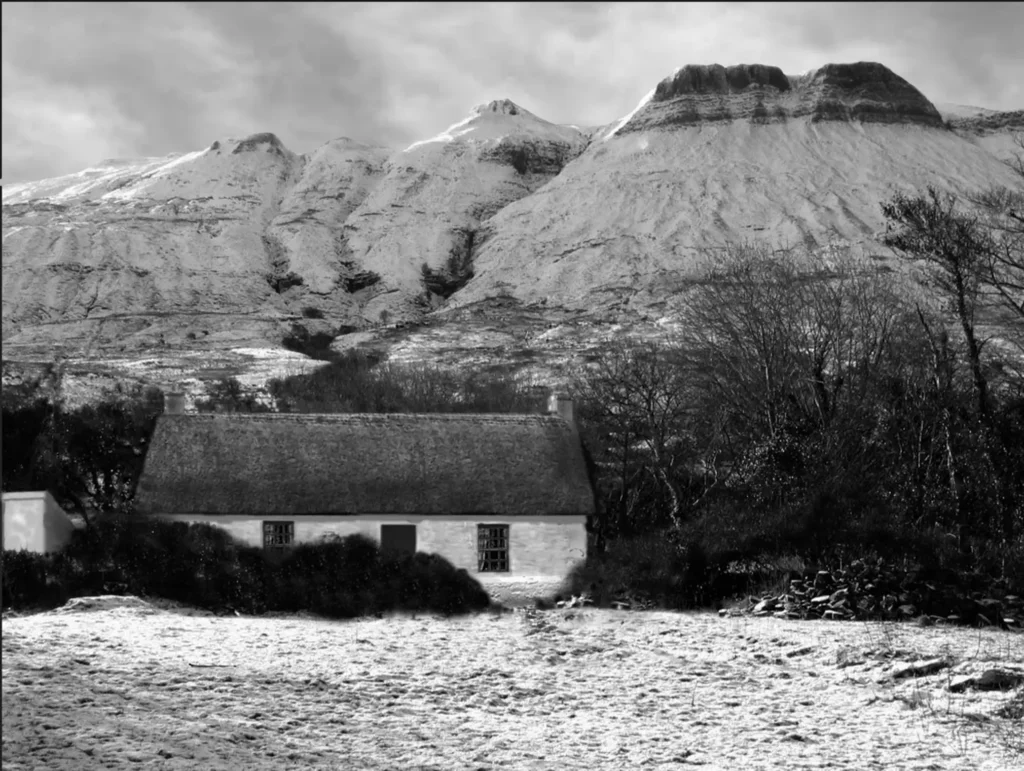
My grandparent’s home is in the mountains of County Sligo. Set below the cliffs of Tievebaun meaning (white mountain) I spent much of my early childhood years growing up there. My grandmother, Margaret, a mystical woman had a significant influence on me and believed in preserving our folklore. A farmer’s wife, she spent a good deal of her 83 years living on the slopes of this mountain and its wild glaciated lands, where she was tuned into the historical, mystical, and legendary wonders that enveloped the area. She endeared me with these qualities, which allowed my imagination to evolve and develop and serves me well today. Paul Nixon.
The Road at My Door An affable Irregular, A heavily-built Falstaffan man, Comes cracking jokes of civil war As though to die by gunshot were The finest play under the sun. A brown Lieutenant and his men, Half dressed in national uniform, Stand at my door, and I complain Of the foul weather, hail and rain, A pear tree broken by the storm. I count those feathered balls of soot The moor-hen guides upon the stream, To silence the envy in my thought; And turn towards my chamber, caught In the cold snows of a dream. WB Yeats.
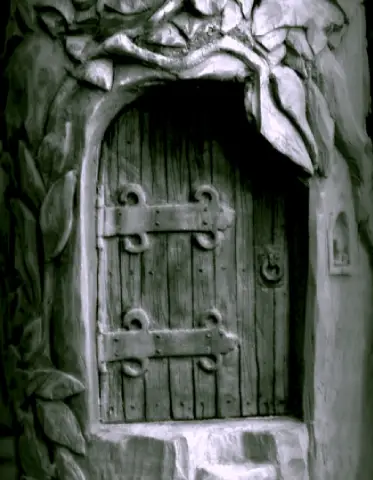
Secret Door. Hand carved cedar wood.

There is another world,” But it is in this one.” WB Yeats.
The Tower of Faces.
SYMBOLS A storm beaten old watch-tower, A blind hermit rings the hour. All-destroying sword-blade still Carried by the wandering fool. Gold-sewn silk on the sword-blade, Beauty and fool together laid. WB Yeats.


Hand carved woodland faery, Paul Nixon.
But I can lead you, newly-married bride, Where nobody gets old and crafty and wise, Where nobody gets old and godly and grave, Where nobody gets old and bitter of tongue, And where kind tongues bring no captivity; For we are but obedient to the thoughts That drift into the mind at a wink of the eye. ” WB Yeats.
Hand-carved Cedarwood, Paul Nixon
The Alchemist. ‘When supernatural events begin, a man first doubts his testimony, but when they repeat themselves, again and again, he doubts all human testimony.’ WB Yeats. Alchemy is one of the most curious subjects in the history of science–it evokes both method and magic in the popular imagination. Where got I that truth? Out of a medium’s mouth, Out of nothing, it came, Out of the forest loam, Out of dark night where lay The crowns of Nineveh.
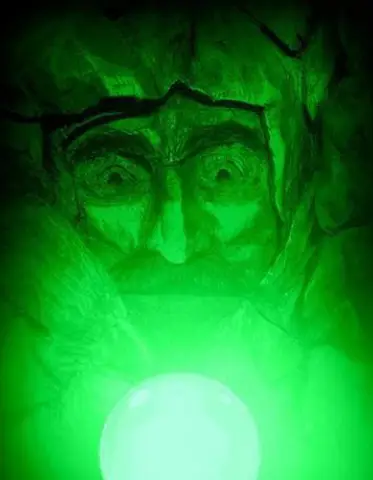
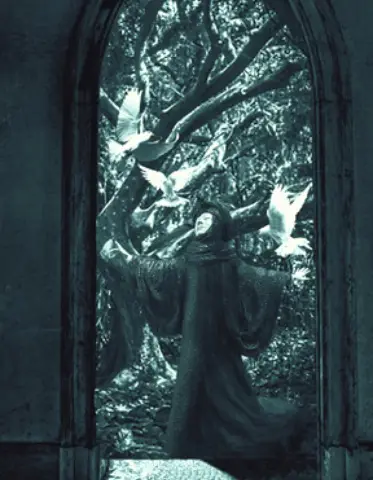
A sculpted cement figure is set into the digitally created image.
” Ah, faeries, dancing under the moon, A Druid land, a Druid tune! While still, I may, I write for you The love I lived, The dream I knew.” WB Yeats.
Hand-carved cedar wood. Luanantishee, guardians of the blackthorn tree.
The Lunantisidhe is another type of fairy and protector of the blackthorn tree. Although they appear thin and wrinkled, they are very agile for their aged appearance. They have long, pointed, sharp teeth, pointed ears, long arms, and fingers, which enable them to move about the twisted thorn branches they call home. May is their year’s height as the blackthorn comes into bloom and is timed with the first full moon called the flower moon. The Lunantisidhe live in groups that are said to hate humans with a fiery passion.
Lunantisidhe is an odd blending of the Latin word Luna (Moon) and the Gaelic Sidhe (fairy). Their sole purpose is to protect the blackthorn tree from encroachment. The only time they will leave the trees is to pay homage to the moon goddess at the Esbats. ( Esbats celebrate the 13 full moons that occur each year). They are lunar and represent the goddess at the height of her power.
Paul Nixon, Irish folklore.
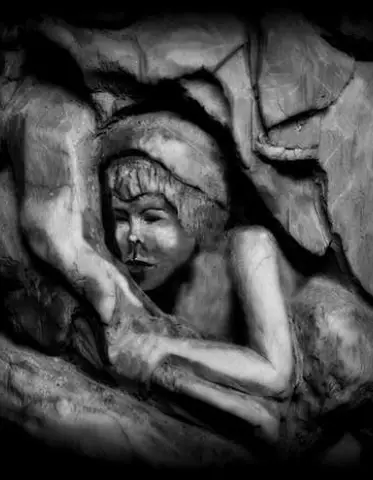
In the heart of solitude, the abandoned house stood as a silent witness, its crumbling facade a reflection of forgotten dreams. Within its dilapidated walls, the echoes of laughter and whispers of yesteryears mingled with an empty silence, weaving its tale of seclusion and decay.
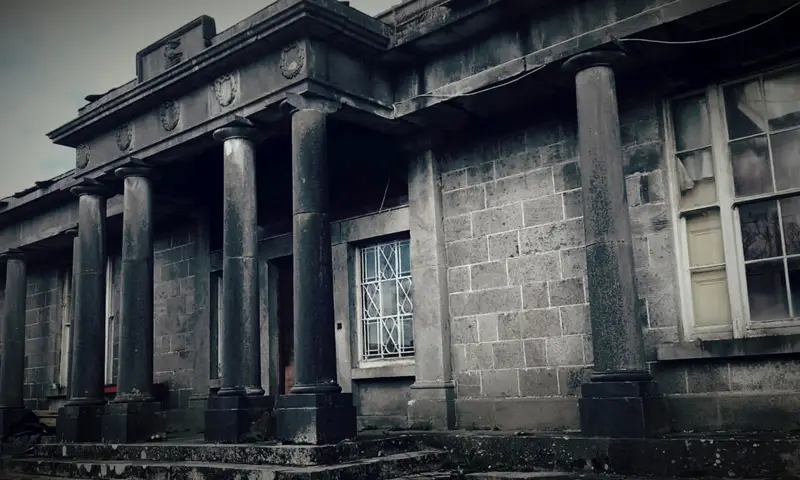
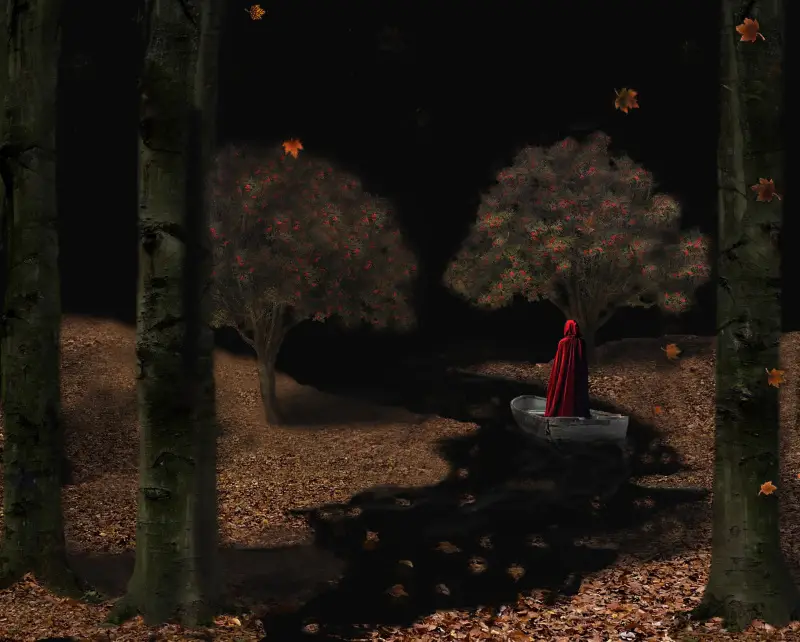
The Ferry Master, The final journey.
The falling of the Leaves. Autumn is over the long leaves that love us, And over the mice in the barley sheaves; Yellow the leaves of the rowan above us, And yellow the wet wild-strawberry leaves. The hour of the waning of love has beset us, And weary and worn are our sad souls now; Let us part, ere the season of passion forget us, With a kiss and a tear on thy drooping brow. WB Yeats.

My rendition of The Wind in the Willows.
Cathbad The Druid. Sculpted cement figure set into a created image.
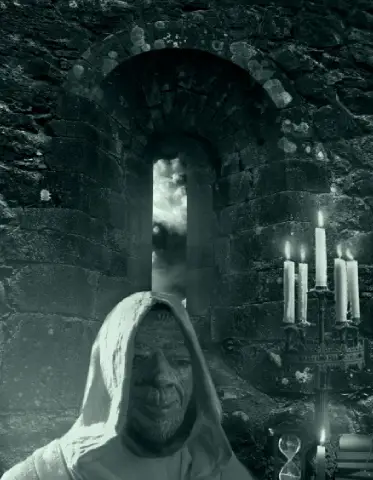
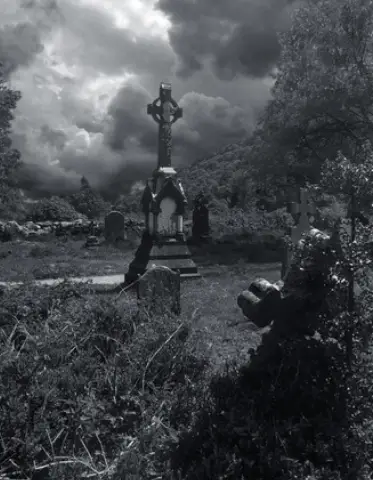
Timeless Light. Glendalough, Wicklow, Ireland.
Her Anxeity Earth in beauty dressed Awaits returning spring. All true love must die, Alter at the best Into some lesser thing. Prove that I lie. Such body lovers have, Such exacting breath, That they touch or sigh. Every touch they give, Love is nearer death. Prove that I lie. WB Yeats.
Timeless Light. Glendalough, Wicklow, Ireland.
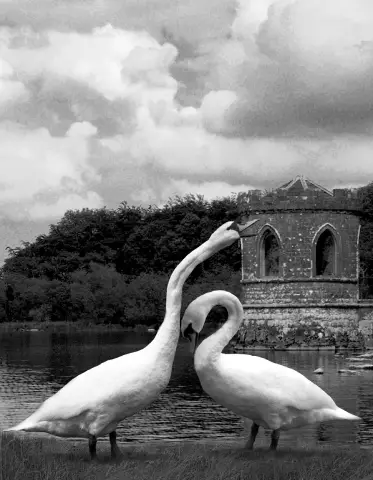
Ironically, Ailill misses the meeting due to a sleeping spell cast upon him by Midir who, in truth, attempts to use a physical glamour so Étaín will sleep with him and remember her former life instead. She is too clever for her former sídhe husband, however, and recognizes that something is amiss. Three times she refuses to sleep with “Ailill” until Midir finally reveals himself as the true man she is meeting. He tells her of her past with him, but she refuses to leave her new husband, Eochaid, and the life she grew to love. However, she does confess that if Eochaid gave her permission to go with Midir, she would not object. In an attempt to win back his born-again wife, Midir approaches Eochaid in human form numerous times, gambling away all sorts of riches and treasures in an effort to persuade Eochaid. Eochaid, knowing what Midir truly wants, sets the sídhe a series of tasks which Midir completes successfully, after which Midir challenges Eochaid one last time, this time winning and demanding a kiss from Étaín as his prize.
However, instead of merely taking what he requested and was granted by Eochaid, Midir embraces Étaín in such a way that she remembers their former happy life together. To the shock and dismay to all present, including the King, the couple rises into the air transforming into two swans and fly back to Midir’s fairy realm.
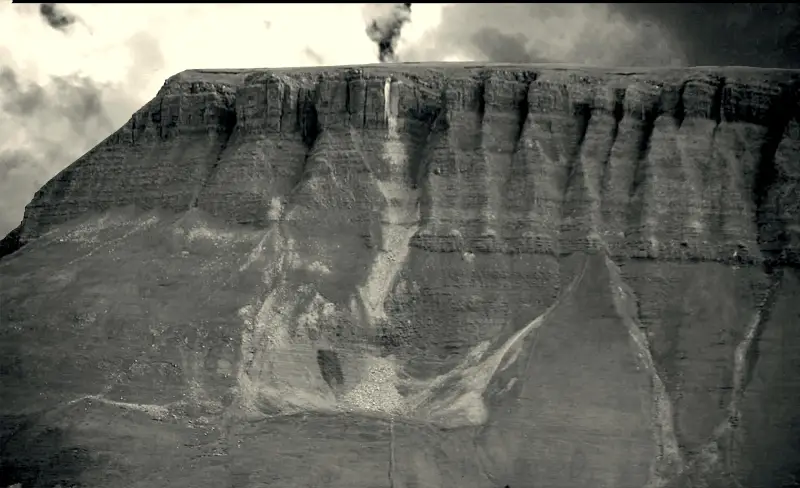
The Moods TIME drops in decay, Like a candle burnt out, And the mountains and woods Have their day, have their day; What one in the rout Of the fire-born moods Has fallen away? WB Yeats
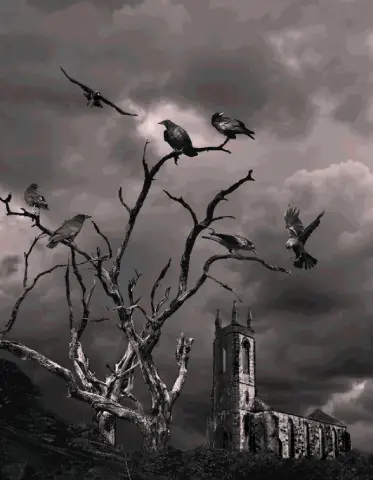
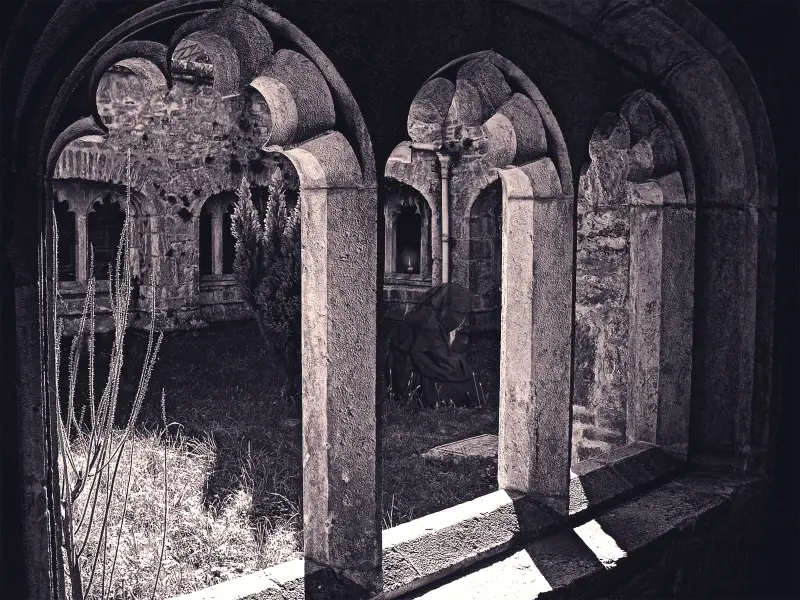
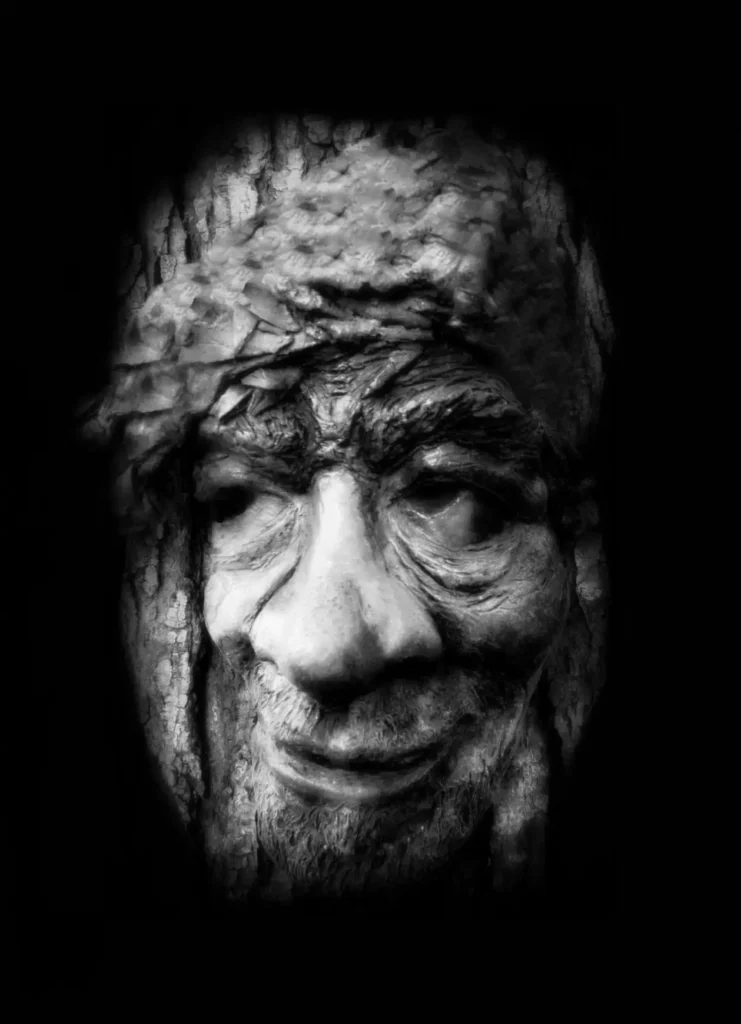
The Apparitions Because there is safety in derision I talked about an apparition, I took no trouble to convince, Or seem plausible to a man of sense. Distrustful of that popular eye Whether it be bold or sly. Fifteen apparitions have I seen; The worst a coat upon a coat-hanger. I have found nothing half so good As my long-planned half solitude, Where I can sit up half the night With some friend that has the wit Not to allow his looks to tell When I am unintelligible. Fifteen apparitions have I seen; The worst a coat upoTn a coat-hanger. When a man grows old his joy Grows more deep day after day, His empty heart is full at length, But he has need of all that strength Because of the increasing Night That opens her mystery and fright. Fifteen apparitions have I seen; The worst a coat upon a coat-hanger.THE APPARITIONS Because there is safety in derision I talked about an apparition, I took no trouble to convince, Or seem plausible to a man of sense. Distrustful of that popular eye Whether it be bold or sly. Fifteen apparitions have I seen; The worst a coat upon a coat-hanger. I have found nothing half so good As my long-planned half solitude, Where I can sit up half the night With some friend that has the wit Not to allow his looks to tell When I am unintelligible. Fifteen apparitions have I seen; The worst a coat upon a coat-hanger. When a man grows old his joy Grows more deep day after day, His empty heart is full at length, But he has need of all that strength Because of the increasing Night That opens her mystery and fright. Fifteen apparitions have I seen; The worst a coat upon a coat-hanger. WB Yeats.
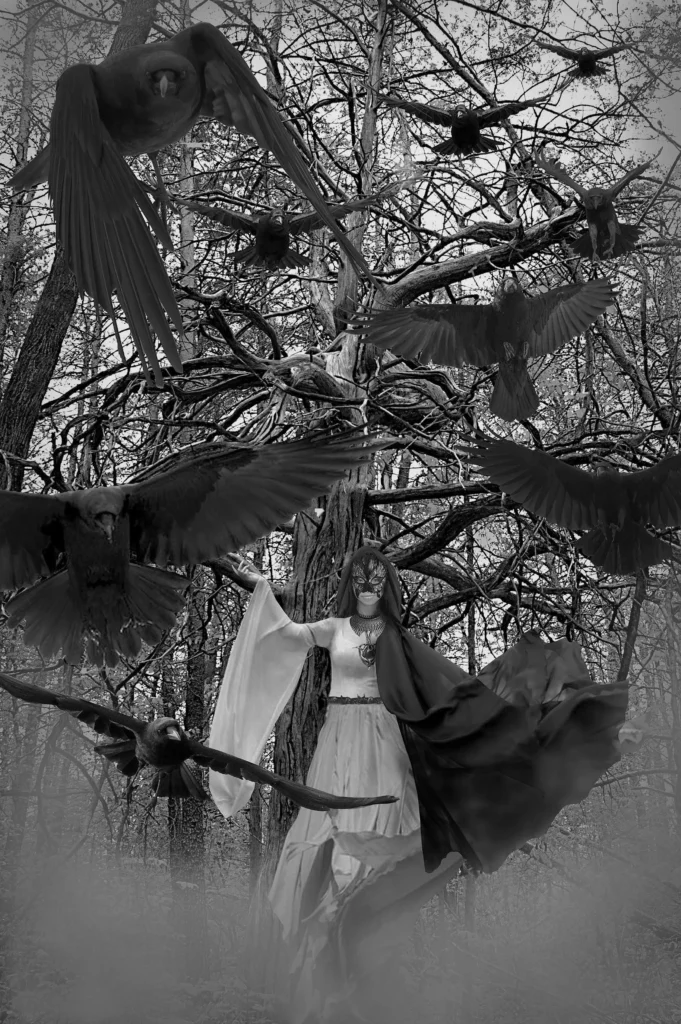
Rise of the Morrigan. My daughter had the perfect expression for me to create this image.
In the tales of the first people of Ireland, the Tuatha De Danann (literally the people of the Goddess Danu), Morrigan was said to have blown a protective fog over all the lands so that they would not be invaded. This shows the strength of Morrigan and the protection the people received from her. Morrigan is also connected with death, destruction, and battles. Paul Nixon, Irish folklore.
In Irish mythology, Finn Mac Cumhail, the legendary leader of Ireland’s heroic band of warriors known as the Fianna, cornered a beautiful white deer, which his hounds then refused to dispatch. That night Finn was visited by the goddess Sadb, who explained that a spell had turned her into the deer Finn had chased, a spell from which his love could release her. Though they became lovers, the magician who cast the spell reclaimed Sadb when Finn was away repelling a Viking raid on Dublin, and though the Fianna searched the land, Sadb could not be found. Some years later, however, another of Finn Mac Cumhail’s hunting sorties tracked down a naked, long-haired boy whom, once again, his hounds refused to kill. The boy did not know his father, but knew his mother as a gentle kind who lived in fear of another man. Details of the story convinced Finn that this was his son, and he named him Oisin, meaning fawn. Oisin, too, became a heroic Fenian warrior, though he also inherited some of his mother’s gentler arts and was acknowledged as Ireland’s greatest poets. Paul Nixon, Irisk folklore.
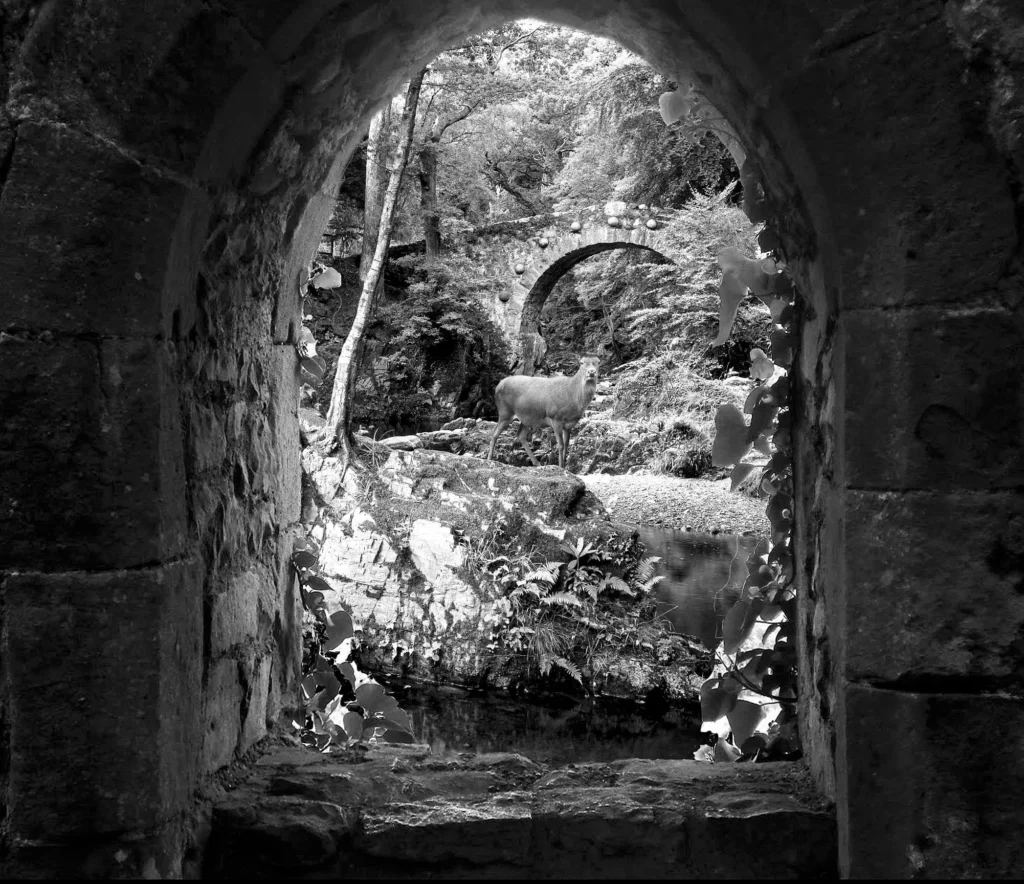
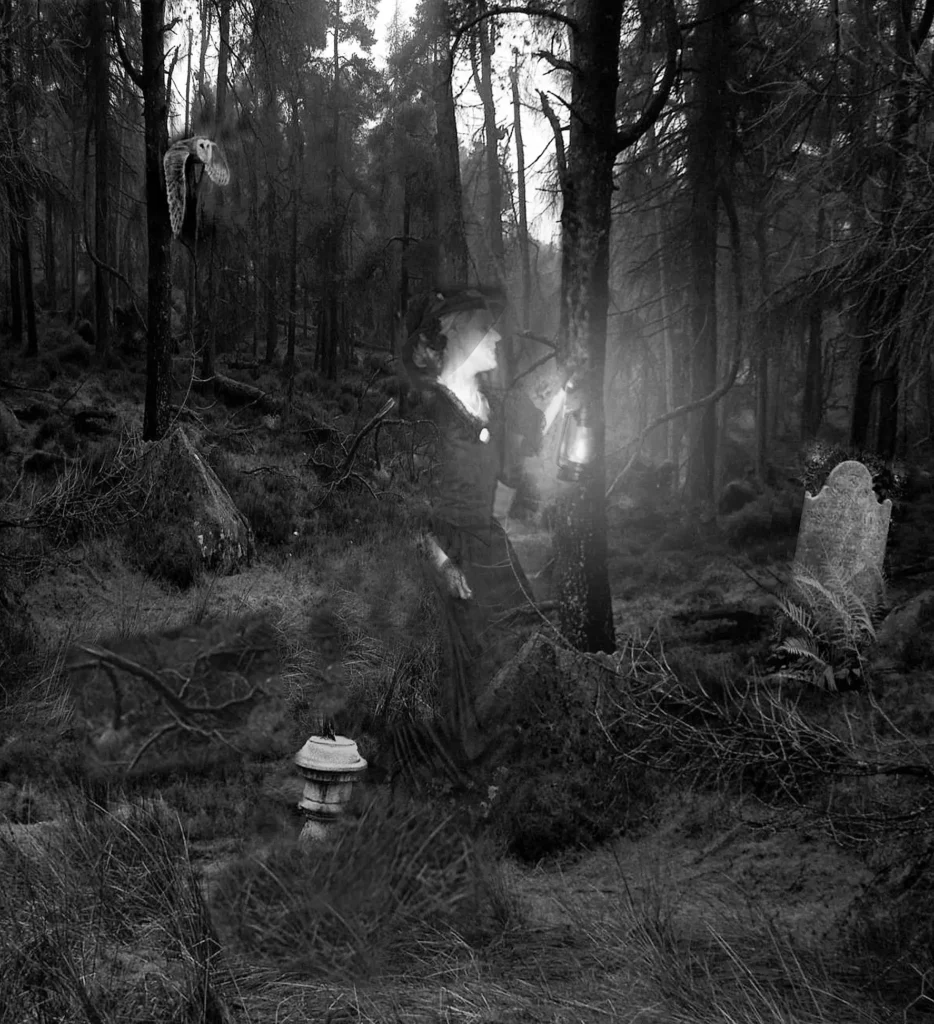
An ancient Hathorn tree being protected by a great boulder.
In 2018, while returning home to Dublin from the West of Ireland. My family and I stopped for a picnic lunch in West Meath at an abandoned farmhouse in a rural setting. My brother Peter had been there before and suggested this a peaceful place to stop. Exploring this area, in a field next to the house, I came across this old Hawthorn tree. With an enormous-sized boulder leaning against its trunk. The Hawthorn is considered a very sacred tree to the fairies and is considered to boast the most sinister reputation in Celtic tree lore. Because of these trees and flowers in the spring, it was associated with the festival of Bealtaine, a sacred time In Irish mythology. The beginning of summer started with the Fire Festival at Beltane. Great bonfires would mark a time of purification and transition. It signaled the season in the hope of a good harvest later in the year. They were accompanied by rituals to protect the people from harm by otherworldly spirits. Serious ramifications were known to occur when one of these trees was cut down to clear the land. Farmers who have caused such destruction, well, their lives would suffer great misfortune for the rest of their days. Those that heeded the fairy warnings would protect their trees by placing rocks and boulders around their base to protect the trunk from damage when the farmer plowed his land. This belief was taken so seriously that in 1999 the upgrading of the National route from Limerick to Galway was delayed. Rerouted and ultimately opened nearly ten years after it was supposed to have started. The Clare County Council, as part of their Contract, had to protect the fairy tree access, which was not permitted within a minimum of a 5m radius. A protective fence has been erected around it. The Hawthorn was often seen as a gateway into the fairy realms.
Thomas the Rhymer, a Scottish poet in the C13 Th, claimed to have met the Fairy Queen by a Hawthorn bush from which a cuckoo was calling. She led him into the Otherworld for a short visit, but when he emerged, he found seven years had passed. On a darker note, there has existed as long as the doctrine decreed by the 5th century St Augustine of Hippo. Who stated that unbaptized babies who had not received baptism could not be buried in consecrated ground, the church graveyard? It was believed that instead, they would go to Limbo and be lost forever. The Limbo of the Infants was a realm of the afterlife. This was exclusively for the souls of unbaptized babies. These souls were in a blissful state, but they stopped just short of the great bliss of heaven. This was scant comfort for many sorrowful parents. Limbo was also taught up until the 1990s. How I recall the scary tales being put on us by the Nuns who were considered the brides of Christ. This was a rather chilling belief that the souls of the unbaptized were destined to bear a candle for eternity, looking for the mercy of God. What gracious God would be capable of such cruel mercy on an innocent child? Babies who died before baptism would be brought in secret, away at night from the public. Private burials were carried out merely by men, by lantern light, by the father, and by male relatives. Women had no role to perform, and the mother was never present. The deceased would be transported to the ruins of an ancient Catholic or Protestant church. Both were considered consecrated grounds. That would allow the mother and family some peace of mind.
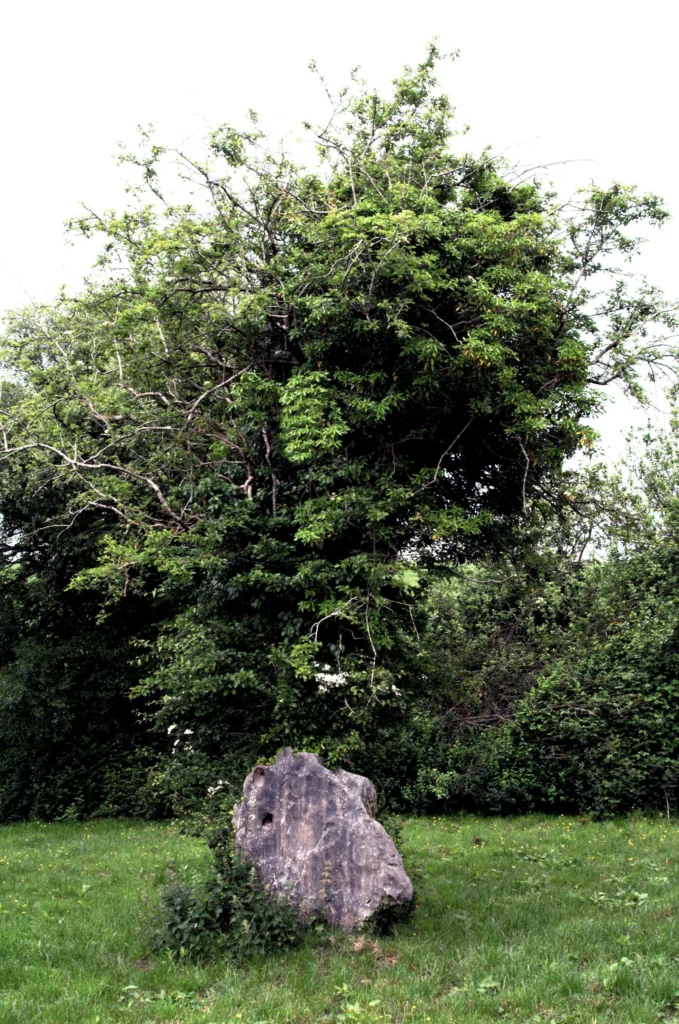


A folk belief regarding this custom was that if the mother brought the child herself, it would increase the chances of her bringing another in the future. If all else failed a burial, placement according to location, the deceased would be buried in a fairy fort or beneath a Hawthorn tree with the belief that the fairies would care for these souls as their own. Ghosts associated with unbaptized children come in various shapes and sizes depending again upon the county in question. Most counties’ folklore has them appearing as Will-0-The Wisp in parts of Yorkshire, England; they seem as nightjars and Cornwall, and in Devon as Pixies. On the Isle of Man, folklore suggests an unbaptized baby would be tasked throughout eternity to carry a light within its hands (somewhat similar or Will-o’-the-wisp). One tale described in Manx Folklore by William Cashen concerns fishermen who would hear a youngster crying each night on the shore. The youngster was that of an heiress of Eary Cushin, who had fallen pregnant out of wedlock and disposed of her baby so that she would be unashamed. Hence, the child was unbaptized. A fisherman called out to the crying child, inquiring, “why do you cry each night.” The youngster replied, “I cry because I have no name.” The fisherman replied, “Should you be a girl, your name is Joney” and if you’re a boy John.” Satisfied, the ghostly child was unheard again. Some have said the big rock looks like a cow’s head, and I have to agree it has that same outline. Ireland’s beef and dairy industry represents a vital component of its economy. The rich, rolling farmland around south Munster and Leinster suits cattle rearing perfectly; unlike sheep, they call for suitable land to thrive. In many ways, cattle were a symbol of prosperity. It’s no surprise that they feature prominently in Irish folklore and history. In days past, long ago, the people tied a red rag around the cow’s tail after calving so the fairies could not persuade her, and then they would splatter holy water on her. They would ignite a blessed wax candle. A girl would stand to one side of the cow and a man on the other flank. The girl would then hand a candle under the animal to the man, who would bear it around again to venerate the animal. Those mischievous fairies were always a threat to cattle, and steps had to be taken to defend them. At one time, hawthorns were sincerely believed to be invariably Witches who had miraculously transformed themselves into sacred trees. Witches have long danced, performed their rites beneath the thorn, and managed their branches to produce wands. Wands constructed of this wood possess great power. Look carefully at this tree, and you will recognize the stern face of a witch watching over its sacred ground. According to Geoffrey Grigson, the haws are also called ‘hags and might represent a direct connection with the old Irish Hag-Mother. Paul Nixon.
The Death of Cuchulain
by William Butler Yeats A man came slowly from the setting sun, To Forgail’s daughter, Emer, in her dun, And found her dyeing cloth with subtle care, And said, casting aside his draggled hair: ” I am Aleel, the swineherd, whom you bid Go dwell upon the sea cliffs, vapour hid; But now my years of watching are no more.” Then Emer cast her web upon the floor, And stretching her arms, red with the dye, Parted her lips with a loud sudden cry. Looking on her, Aleel, the swineherd, said: ” Not any god alive, nor mortal dead, Has slain so mighty armies, so great kings, Nor won the gold that now Cuchulain brings.” ” Why do you tremble thus from feet to crown?” Aleel, the swineherd, wept and cast him down Upon the web-heaped floor, and thus his word: ” With him is one sweet-throated like a bird.” ” Who bade you tell these things?” and then she cried To those about, ” Beat him with thongs of hide And drive him from the door.” And thus it was: And where her son, Finmole, on the smooth grass Was driving cattle, came she with swift feet, And called out to him, ” Son, it is not meet That you stay idling here with flocks and herds.” ” I long have waited, mother, for those words: But wherefore now?” ” There is a man to die; You have the heaviest arm under the sky.” ” My father dwells among the sea-worn bands And breaks the ridge of battle with his hands.” ” Nay, you are taller than Cuchulain, son.” ” He is the mightiest man in ship or dun.” ” Nay, he is old and sad with many wars, And weary of the crash of battle cars.” ” I only ask what way my journey lies, For God, who made you bitter, made you wise.” ” The Red Branch kings a tireless banquet keep, Where the sun falls into the Western deep. Go there, and dwell on the green forest rim; But tell alone your name and house to him Whose blade compels, and bid them send you one Who has a like vow from their triple dun.
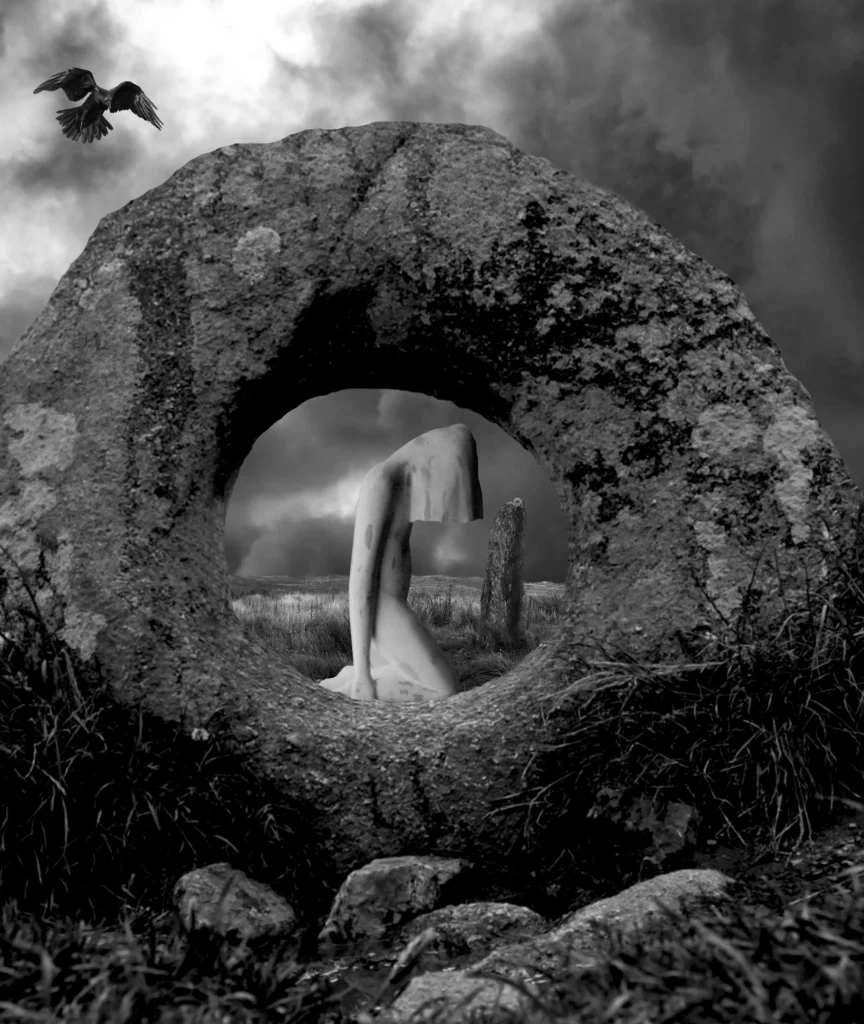
Between the lavish shelter of a wood And the gray tide, the Red Branch multitude Feasted, and with them old Cuchulain dwelt, And his young dear one close beside him knelt, And gazed upon the wisdom of his eyes, More mournful than the depth of starry skies, And pondered on the wonder of his days; And all around the harp-string told his praise, And Concobar, the Red Branch king of kings, With his own fingers touched the brazen strings. At last Cuchulain spake: ” A young man strays Driving the deer along the woody ways. I often hear him singing to and fro, I often hear the sweet sound of his bow. Seek out what man he is.” One went and came. ” He bade me let all know he gives his name At the sword point, and bade me bring him one Who had a like vow from our triple dun.” ” I only of the Red Branch hosted now,” Cuchulain cried, ” have made and keep that vow.” After short fighting in the leafy shade, He spake to the young man, ” Is there no maid Who loves you, no white arms to wrap you round, Or do you long for the dim sleepy ground, That you come here to meet this ancient sword?” ” The dooms of men are in God’s hidden hoard.” ” Your head a while seemed like a woman’s head That I loved once.” Again the fighting sped, But now the war rage in Cuchulain woke, And through the other’s shield his long blade broke, And pierced him. ” Speak before your breath is done.” ” I am Finmole, mighty Cuchulain’s son.” ” I put you from your pain. I can no more.” While day its burden on to evening bore, With head bowed on his knees Cuchulain stayed; Then Concobar sent that sweet-throated maid, And she, to win him, his gray hair caressed; In vain her arms, in vain her soft white breast. Then Concobar, the subtlest of all men, Ranking his Druids round him ten by ten, Spake thus: ” Cuchulain will dwell there and brood, For three days more in dreadful quietude, And then arise, and raving slay us all. Go, cast on him delusions magical, That he may fight the waves of the loud sea.” And ten by ten under a quicken tree, The Druids chaunted, swaying in their hands Tall wands of alder, and white quicken wands. In three days’ time, Cuchulain with a moan Stood up, and came to the long sands alone: For four days warred he with the bitter tide; And the waves flowed above him, and he died.
